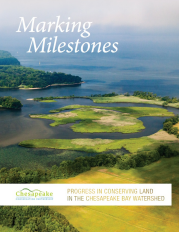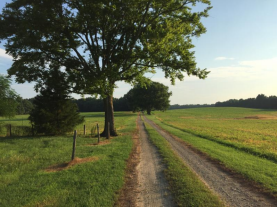Historic Malvern Hill Farm is one of many recent land conservation success stories highlighted in the Chesapeake Conservation Partnership’s major new report released today — Marking Milestones: Progress in Conserving Land in the Chesapeake Bay Watershed. (Photo: Capital Region Land Conservancy)
 “LAND. It’s as important as air but we often take it for granted. Land grows our food, cleans our water, and sometimes even takes our breath away with its beauty. Land anchors life.”
“LAND. It’s as important as air but we often take it for granted. Land grows our food, cleans our water, and sometimes even takes our breath away with its beauty. Land anchors life.”
This is how our new report–Marking Milestones: Progress in Conserving Land in the Chesapeake Bay Watershed–-begins. Hot off the press, the report is the most comprehensive survey of land conservation and funding in a decade.
Marking Milestones showcases the tremendous value of our Chesapeake watershed, and the remarkable success stories of people working to protect the land that supports our quality of life. It also points out the significant financial investments necessary for conserving the lands upon which we all depend — and the return on investment we derive from them.
The report documents where we stand in achieving the Chesapeake Bay Watershed Agreement goal to protect an additional 2 million acres by 2025. The agreement was signed in 2014 by the governors of Delaware, Maryland, New York, Pennsylvania, Virginia, and West Virginia, the mayor of the District of Columbia, the administrator of the U.S. Environmental Protection Agency on behalf of the federal government, and the chair of the Chesapeake Bay
Commission. As of the end of 2018, the Partnership members have conserved over 1.3 million acres toward achieving our 2025 goal. So, we have around 640,000 acres to conserve over the next 5 plus years.
We also provide detailed information on the status of land protection funding programs in the region in recent fiscal years — the first survey of its kind in a decade.
The report calls for a renewed urgency in our shared conservation work. Scientists around the globe warn us that action must be taken now to avert major disruptions to our quality of life. It is not too late for action, but broad, concerted action must be taken now and over the next decade. Land protection is not the only solution, but scientists point to protecting 30 percent of the planet by 2030 as the next essential goal.
Here in the Chesapeake we must do our part—for our own well-being. This is the time for building on past success, maintaining and growing the land conservation funding programs already in place, and developing new conservation financing. All that we care about depends on concerted action.
We hope you will read and share this report widely. And we look forward to our continued work together to advance our shared goals.
_____________________________________________________________________________
“America’s great estuary, with all the benefits it provides, must be managed as a system. The pioneering and farsighted Chesapeake Conservation Partnership report spotlights the remarkable achievement of protecting 22% of the land in the watershed. Yet that is not enough. Emerging scientific consensus recognizes the need to protect 30% of the watershed by 2030 and 50% by 2050 – setting a visionary example for the world on how to save the environment and humanity.”
-Thomas Lovejoy
Known as the “Godfather of Biodiversity”
Senior Fellow at the United Nations Foundation & Professor in the department of environmental science and policy at George Mason University
_____________________________________________________________________________
“The six states within the Chesapeake Bay watershed have some of the leading land conservation programs in the nation. Collectively, these states invested more than $300 million in just one recent fiscal year. The federal government also plays an important role, though at a smaller scale. This report showcases the impact of these efforts and highlights the ongoing commitment of landowners to conserve their lands. But it also documents that landowner interest far exceeds available funding. We should address this head on by growing our state and federal financial resources and technical assistance. After all, conserving land is one of the most sure-fire ways we know of to ensure the health of our watershed.”
-Ann P. Swanson
Chesapeake Bay Commission Executive Director
Lightning Update is a regular communication of the Chesapeake Conservation Partnership. Any opinions expressed are those of the authors and do not necessarily reflect positions of the Partnership or member organizations.
To share a success story, news, or important event, send your information to:
Support for the Chesapeake Conservation Partnership is provided by:
National Park Service Chesapeake
EPA Chesapeake Bay Program
USDA Forest Service
Pennsylvania Department of Conservation & Natural Resources
Maryland Department of Natural Resources
Virginia Outdoors Foundation
US Fish & Wildlife Service
Chesapeake Conservancy
The Chesapeake Conservation Partnership is co-convened by:




